Cryptocurrency Personas
 Photo by Thought Catalog on Unsplash
Photo by Thought Catalog on Unsplash
Interest in cryptocurrency and blockchain boomed in the last year and, as designers, we need to rise to the challenge. It’s a brave new world out there.
When I started working fulltime for a crypto company, the first thing I did was user research. I read surveys, I analysed social media, and — most importantly — I spoke to people in person. It’s a new industry; who are we designing for?
Through many hours of interviewing and testing real users, I iterated on a series of personas. They represent the three main types of crypto-investor.
I present them here in the interests of keeping the community open-source — if you think they should be tweaked, let me know! As the industry evolves, so should the personas we use.
One-Page Infographic
 Standalone cards for each persona are below, along with extra information.
Standalone cards for each persona are below, along with extra information.
The Enthusiast
 “Hey Joe, where you going with that gun in your hand?”
“Hey Joe, where you going with that gun in your hand?”
This guy represents far and away the largest group of people. I initially suspected the majority of the enthusiastic geeks (and I say that lovingly, as one myself) would have got in earlier, around 2015. Once I started reading surveys like this and this, I realised just how many people had entered the space in 2017. My second assumption was that many who entered in 2017 would lack the knowledge of the really early adopters. Once I started meeting these users, I realised they actually knew a heck of a lot and had become obsessed very quickly — probably because they kicked themselves for not getting involved earlier. Partly because they love the ideas so much, they hate scams, hype and bullshit.
- They care about decentralization.
- They care about the faults of the current monetary system.
- They also still care about token price.
They might be ideologically driven and “in it for the tech”, but it’s a mistake to assume the largest sector of the market ignores the value of their investments. It’s also important to note that, at time of writing (September 2018) anybody who got involved in late 2017 has probably seen their portfolio fall by ~80%, and their outlook harden accordingly. Even if they took profits during the good times, it’s hard to overstate what that kind of drop feels like.
The people still around might be true believers, but might also be some of the most cynical bastards you’ve ever met.
The Newbie
 “Rose is a rose is a rose is a rose.”
“Rose is a rose is a rose is a rose.”
A small but important section of the audience. After bitcoin’s price exploded, a number of young, tech-savvy, people decided to look into it. They know they missed the big bull run, but occasionally they throw in a few dollars on Coinbase, just to get an idea of how it works. They don’t share the same ideology of the crypto-enthusiast. They do, however, use financial apps regularly and are of a generation where Venmo, Monzo and Revolut have made it normal to manage money with their phones; and Google Pay, Apple Pay and WeChat have made it easy to pay using QR codes and NFT. The moment this user can easily buy, sell and send cryptocurrency is the moment mass adoption begins. They need clear explanations and tangible examples.
They are intrigued by crypto but don’t see the point, only the hassle.
The Curious Investor
 There is another type of user that I had overlooked before I got deeply involved in this world: the traditional investor who explores the cutting-edge. There aren’t as many Clives as there are Joes, but they play with a lot more money. Plenty of people from traditional finance and venture capital backgrounds have been carefully observing crypto for some time, they just don’t shout about it. While the enthusiast didn’t really get into crypto until 2017, then preached to everyone they knew, this persona had been keeping an eye on the market for years and quietly studying opportunities.
There is another type of user that I had overlooked before I got deeply involved in this world: the traditional investor who explores the cutting-edge. There aren’t as many Clives as there are Joes, but they play with a lot more money. Plenty of people from traditional finance and venture capital backgrounds have been carefully observing crypto for some time, they just don’t shout about it. While the enthusiast didn’t really get into crypto until 2017, then preached to everyone they knew, this persona had been keeping an eye on the market for years and quietly studying opportunities.
He’s older, more careful, and simply has more money. When he put in a “small amount”, it was probably several thousand as a calculated, high-risk, investment. It is quite likely his portfolio reached six, or even seven, figures at the peak of the boom.
- Knowledgeable about economic theory.
- Prefers desktop to mobile.
- Wants professionalism to replace memes.
- Reads financial newspapers.
- Extremely careful about KYC, AML, and tax issues.
- Wants phone support for anything financial.
I don’t see much written about this user, but there are more than you think. It’s something to bear in mind when designing experiences. Even such simple things as font size and icon choice become important when you realise you’re designing for many over-40s/50s, instead of just the 20s/30s crowd.
A Word on Price
Volatility is still high, and many outside this world see it as an experiment doomed to fail. Bitcoin has been declared dead over 300 times. When the price of cryptocurrency soars, crypto twitter explodes with memes of Lamborghinis and “to the moon!” When it crashed in January 2017, the cryptocurrency subreddit pinned the suicide prevention hotline to the top of the page…
You can’t sugarcoat it, money makes people emotional.
That’s going to affect our personas.
I’ll close with some thoughts on how I think each will adapt to the market cycle, based on user research.
But first, here are three graphs, showing:
- The total market cap (the combined value of all cryptocurrencies) on a linear scale over the last 12 months.
- The total market cap on a linear scale since 2013.
- The total market cap on a logarithmic scale since 2013.
1. Market cap, linear scale: 2017–2018

2. Market cap, linear scale: 2013– 2018

3. Market cap, log scale: 2013–2018
 I make no comment on the predictive value of such graphs, but I will say that the log scale reveals a very different picture to the linear scale. We also know that most users entered the space late 2017, so the 1-year graph gives a detailed view of their experience so far.
I make no comment on the predictive value of such graphs, but I will say that the log scale reveals a very different picture to the linear scale. We also know that most users entered the space late 2017, so the 1-year graph gives a detailed view of their experience so far.
The Enthusiast is angry at projects that fail their objectives and, during downturns, probably wants assurance from token teams that they are doing everything they can to succeed. During upturns, he will be exuberant and be crypto’s loudest cheerleader.
The Newbie largely ignores the graphs and doesn’t have much invested anyway. She’ll lose interest while the price slumps and is waiting for adoption and UX improvements. Interestingly, some early investors began as this kind of persona and forgot all about the modest sum they invested in 2015, until the price rise caught their attention a couple of years later and they logged in to their old accounts to discover they were rich.
The Traditional Investor cares mostly about the log scale graph and responds with less emotion.
**********
These are the personas we used, built off real conversations I had with dozens of users. I hope you find them useful, and I look forward to seeing user-centred design transform the cryptocurrency space over the coming years!






























